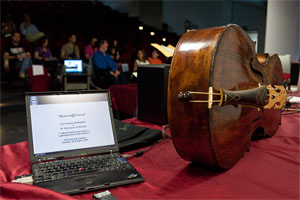Researchers bring the sounds of ancient instruments back to life

Ever heard or heard of a salpinx, barbiton, aulos, or syrinx? Well, neither has anyone else, for centuries (at least heard them). Until now.
These ancient instruments were common in civilizations past, but have long since been forgotten. To create and play them is a challenge as clues come in the form of archaeological data such as fragments from excavations, written descriptions, and pictures. But that's enough for a team of researchers to reconstruct the sound or timbre of ancient instruments. The ASTRA (Ancient instruments Sound/Timbre Reconstruction Application) project accomplishes this feat using physical modeling (computer synthesis) and grid technology.
In their words, the ASTRA application is designed to "recreate a model of the musical instrument and produce the sound by simulating its behavior as a mechanical system."
The computations needed to simulate the sounds are quite intensive (it takes about four hours for a high powered computer to correctly reproduce a sound lasting only 30 seconds), so ASTRA is using the high-speed networks GÉANT2 and EUMEDCONNECT and the EGEE (Enabling Grids for E-sciencE) computing infrastructure.
To model the sound of a drum, for example, there would be a formula for how striking the drumhead injects energy into a two dimensional membrane. ASTRA explains, "Thereafter, the properties of the membrane (mass density, stiffness, etc.), its coupling with the resonance of the cylindrical body of the drum, and the conditions at its boundaries (a rigid termination to the drum's body) would describe its movement over time and thus its generation of sound."
The team successfully reconstructed the sound of an early stringed instrument called the epigonion, and it was featured in a special concert late last year (video) by ASTRA's orchestra, The Lost Sounds Orchestra.
Now ASTRA is working on a whole host of other lost instruments including the salpinx (a kind of ancient trumpet), the barbiton (an ancient base guitar), the aulos (an ancient oboe) and the syrinx (a pan flute), and more are on the horizon.
Sources: Physorg, Lost Sounds Orchestra, ASTRA
Related music research links:
